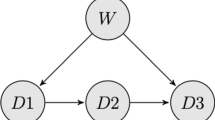Abstract
Temporal analyses of causal directionality fail if causes needn't precede their effects. Certain well-known difficulties with alternative (non-temporal) analyses have, in recent accounts, been avoided by attending more carefully to the formal features of relations typically figuring in philosophical discussions of causation. I discuss here a representative of such accounts, offered by David Sanford, according to which a correct analysis of causal priority must issue from viewing the condition relation as nonsymmetrical. The theory is shown first to be an implicitly counterfactual treatment at its base: this provides for an explicit reformulation of several key notions in the theory. An argument is then presented, independent of these modal considerations, for the conclusion that causal priority is possible only given certain implausible assumptions about the asymmetric character of causal laws which, I claim, are not met. The best objection to this argument is shown to fail on several counts, partly in light of the counterfactual results offered earlier. It is concluded that, if laws are symmetric, analyses of the sort discussed must look elsewhere for the source of causal priority; but if laws are not symmetric, resting causal priority so heavily on nomological asymmetry is no analysis at all.
Similar content being viewed by others
Author information
Authors and Affiliations
Rights and permissions
About this article
Cite this article
Cover, J.A. Causal priority and causal conditionship. Synthese 71, 19–36 (1987). https://doi.org/10.1007/BF00486434
Issue Date:
DOI: https://doi.org/10.1007/BF00486434



